Blog

Top 5 Virtual Office Software for Remote and Hybrid Teams
As remote work continues to grow, virtual office software is changing how businesses run and how teams connect. Many companies are shifting from traditional office spaces to remote or hybrid work models.
This change has led to the development of tools that help remote teams stay connected and productive, even when members work from different places.
That’s where virtual office software comes in. It helps remote and hybrid teams work together as if they were in the same physical space.
In this guide, you’ll learn what a virtual office is, its key features, and the best tools to run your virtual workspace efficiently.
What Is a Virtual Office?
A virtual office is an online workspace that lets employees connect, communicate, and collaborate without needing a physical office. It replaces traditional office setups with digital tools that help teams work from anywhere.
Think of it as your office moved to the cloud. You can chat with coworkers, join meetings, share files, and manage projects — all from your computer. This setup is ideal for remote or hybrid teams that want to stay organized and maintain company culture while working online.
Virtual Office Software
Virtual office software is the tool that powers this online workspace. It combines communication, collaboration, and management features to keep remote teams aligned.
A good virtual office tool helps teams:
-
Work together in real time
-
Communicate easily through chat or video calls
-
Share files and updates instantly
-
Track tasks and progress
-
Maintain productivity from anywhere
For companies shifting to hybrid or remote setups, virtual office software is essential. It brings everyone together in a shared digital environment where work gets done smoothly.
Key Features of Virtual Office Software
When selecting the best virtual office software for remote and hybrid companies, it’s important to understand which features will provide the most benefit.
Here are some of the key features that virtual workspace software typically offers:
Video Conferencing
Video conferencing enables real-time face to face communication, regardless of location. With the ability to share multiple screens, video conferencing enables users to have more effective meetings, especially for each remote team.
Many platforms also include options for spatial audio, which makes conversations feel more natural, as if everyone were in the same room.
Direct Messaging
Quick and focused conversations are possible through built-in messaging features. This is a key feature for:
- Real-time discussions
- Task updates
- Informal chats
It lets teams communicate seamlessly throughout the day, especially for a hybrid team that may have members working in different locations.
File Sharing
File sharing within a virtual office allows teams to collaborate on projects easily. It helps in tasks such as:
- Sharing presentations
- Providing documents
- Presenting project briefs
Advanced features like version control keep everyone working on the most up-to-date document.
Scheduling and Calendar Integration
With built-in calendar integration, scheduling virtual meetings is easy. This allows for seamless communication and reduces scheduling conflicts, which is especially useful for remote teams spread across multiple time zones.
Task Management and Collaboration Tools
Teams can keep track of their projects and tasks on their online workspace using integrated task management features.
Project managers won’t need to rely on frequent meetings or check-ins. They can use these features to:
- Assign tasks
- Monitor progress
- Adjust workloads
Team Building Activities
One challenge of working remotely is the lack of spontaneous interactions that help build relationships.
Virtual office platforms provide tools that help foster a collaborative work environment, even for remote teams. From virtual coffee breaks to game sessions, these simulate face to face interactions to build team bonds.
Security and Compliance
For remote teams, security is always a priority. The best virtual office platforms offer features that help companies meet relevant regulations for data protection and privacy. This is especially important when working with sensitive client data or business documents.
Top 5 Virtual Office Software for Remote Teams
Here’s a comparison of some of the most popular virtual office platforms available for remote and hybrid teams:
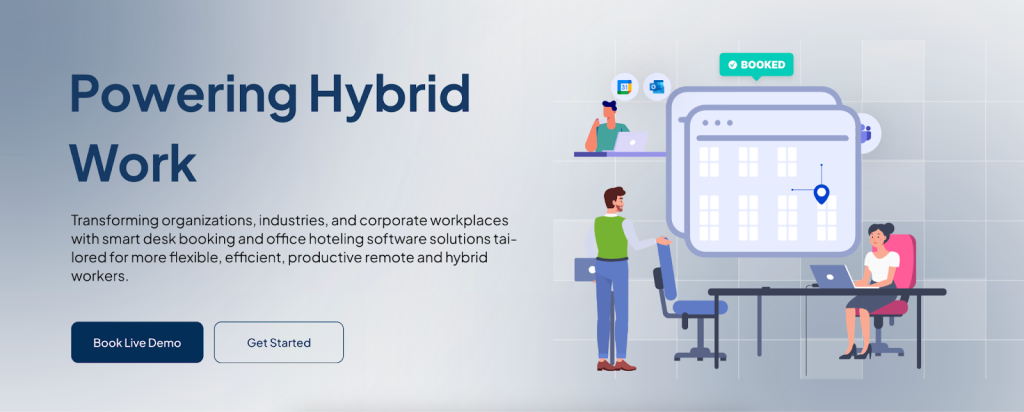
1. DeskFlex
DeskFlex is an all-in-one hybrid workplace management platform. It combines desk booking, meeting room scheduling, and visitor management in one system.
Key features include:
Integrated digital whiteboards and instant messaging
Centralized file sharing and document access
Integration with Microsoft Outlook and Teams
Real-time workflow tracking and time management
Tools for hybrid event planning and performance monitoring
DeskFlex is designed for flexible office usage and data security. It’s ideal for companies that manage both remote and in-person teams.
👉 Book a demo and explore how DeskFlex can optimize your virtual office setup.
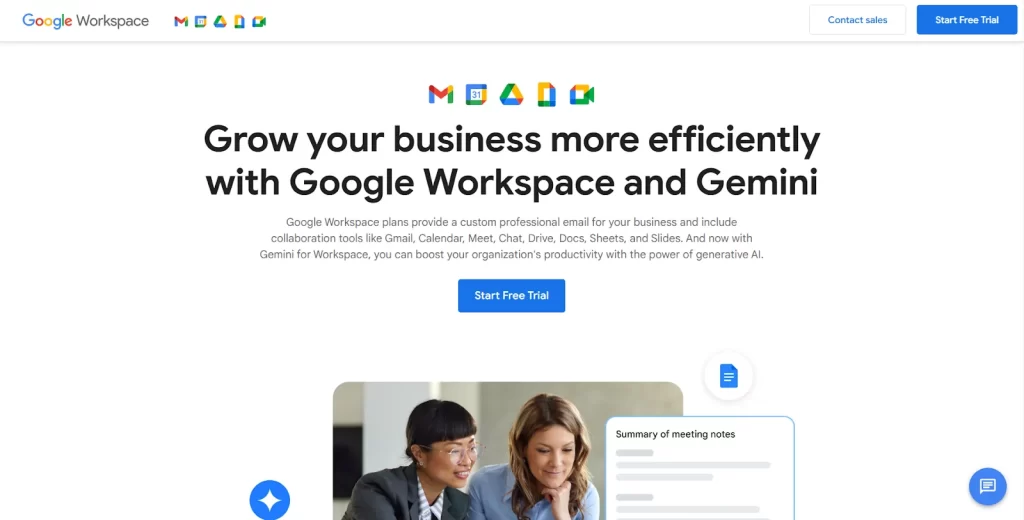
2. Google Workspace
Google Workspace offers a complete set of productivity apps like Gmail, Google Docs, and Google Meet. It’s perfect for teams that collaborate on documents and need seamless communication.
Features include:
Real-time editing and sharing through Docs and Sheets
Central file storage with Google Drive
Easy scheduling with Google Calendar
High-quality video meetings through Google Meet
It’s a reliable option for businesses of all sizes that value simplicity and collaboration.
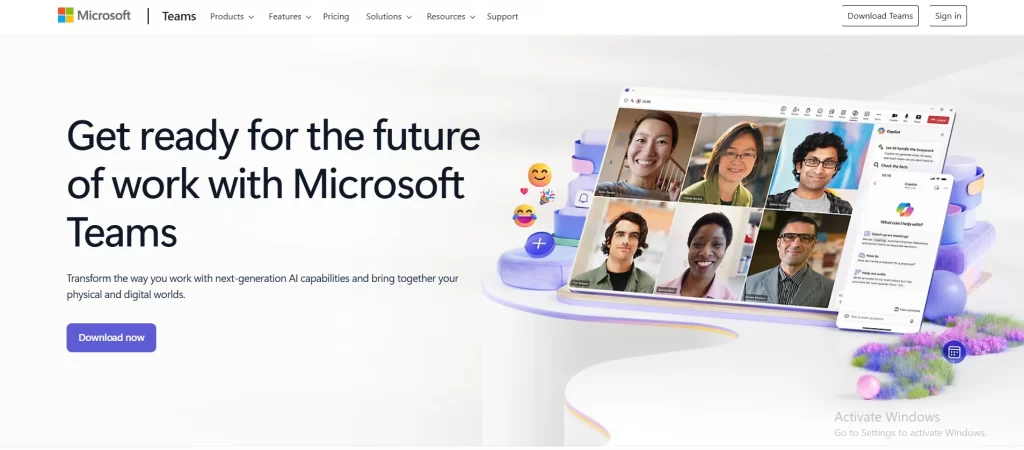
3. Microsoft Teams
Microsoft Teams brings chat, calls, and collaboration into one space. It integrates perfectly with Microsoft Office tools like Word, Excel, and PowerPoint.
Features include:
Organized communication channels for projects and departments
Private chats and direct messages
Built-in video calls and screen sharing
Easy access to shared files and Office apps
If your company already uses Microsoft 365, Teams is an excellent choice for a connected workspace.
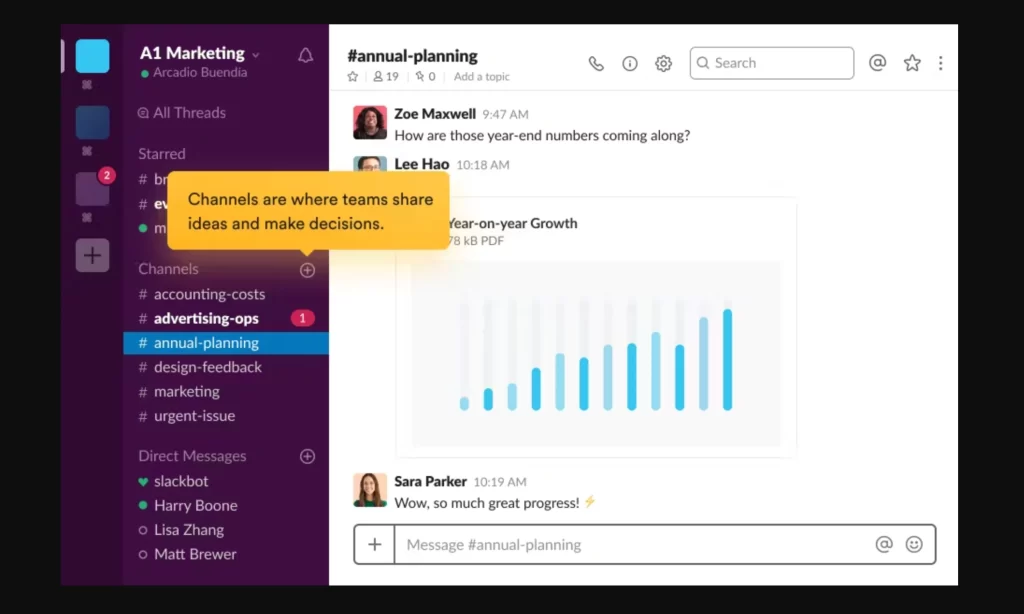
4. Slack
Slack is one of the most popular tools for real-time messaging and team collaboration. It helps teams communicate in organized channels based on topics or departments.
Its top features are:
Group channels and private chats
Integration with over 2,000 apps like Trello and Google Drive
Easy file sharing and powerful search tools
Notifications and reminders for better task tracking
Slack is best for small and medium teams that value fast, clear communication.
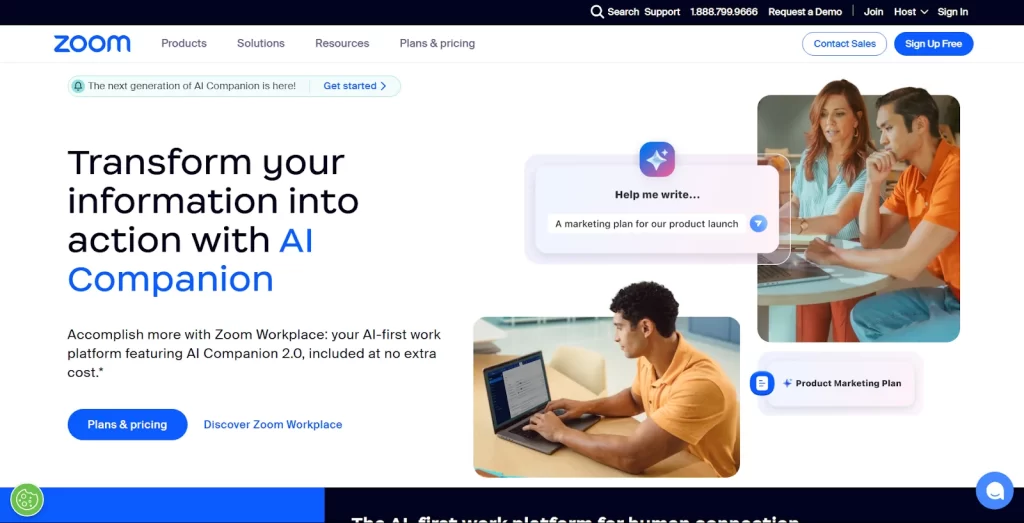
5. Zoom
Zoom is best known for its video conferencing quality. It supports team meetings, webinars, and virtual events with ease.
Main features include:
HD video and audio calls
Screen sharing and breakout rooms
Meeting recordings for future reference
Integration with Google Calendar and Outlook
Zoom is perfect for teams that depend heavily on virtual meetings and face-to-face collaboration.
Top 5 Virtual Office Software – Quick Comparison Table
| Software | Best For | Key Features | Integrations | Ideal Team Type |
|---|---|---|---|---|
| DeskFlex | Hybrid workplace scheduling & space management | Desk/room booking, visitor management, workflow tracking, digital whiteboards, messaging | Microsoft Outlook, Microsoft Teams | Remote + in-office hybrid teams |
| Google Workspace | Productivity & document collaboration | Docs/Sheets real-time editing, Drive storage, Gmail, Calendar, Google Meet | Google apps ecosystem (Gmail, Drive, Meet, Docs) | Small to large teams wanting simple cloud tools |
| Microsoft Teams | Unified communication & Office integration | Channels, chat, calls, screen sharing, file access, Office 365 tools | Word, Excel, PowerPoint, SharePoint, OneDrive | Companies already using Microsoft 365 |
| Slack | Fast internal communication & integrations | Channels, DMs, app integrations (2000+), file sharing, search tools | Trello, Asana, Google Drive & more | Small–mid teams needing real-time communication |
| Zoom | Video meetings & virtual events | HD video/audio calls, webinars, breakout rooms, recordings | Google Calendar, Outlook, Slack | Teams relying heavily on video communication |
Implementation of Virtual Office Software
Once you’ve chosen your virtual office software, the next step is putting it into action. Implementation is not just about installing the tool. It’s about helping your team adopt it effectively so it becomes a natural part of their daily routine.
Here’s a step-by-step approach to make the transition smooth and successful:
1. Identify Your Needs
Start by understanding what your team really needs help with. Is communication the main issue? Do tasks often get delayed because of poor tracking or unclear responsibilities? Knowing these pain points will help you select features and set up workflows that directly solve them.
For example, if your team struggles with meeting organization, focus on tools with strong scheduling and calendar integration. If collaboration is the problem, prioritize platforms with real-time document sharing and chat options.
2. Choose the Right Tool
Not every virtual office platform will fit your team perfectly. Look for software that aligns with your team’s daily habits and integrates well with tools you already use — like email, project management, or CRM systems.
The right tool should be:
Easy to navigate and learn
Scalable as your company grows
Secure, with strong data protection
Compatible with your workflow and devices
A well-chosen platform reduces friction and improves team adoption from day one.
3. Train Your Team
Even the best software can fail if the team doesn’t know how to use it. Offer short, focused training sessions that demonstrate key features such as file sharing, task creation, and communication tools.
Encourage hands-on practice. Let employees explore the platform on their own and share feedback. You can also create a short guide or internal video tutorial to help new members get started quickly. Good training ensures everyone feels confident and comfortable using the new system.
4. Monitor and Adjust
After implementation, take time to observe how your team uses the software. Are employees actively communicating through it? Are meetings easier to manage now?
Collect feedback regularly and identify any issues — such as slow adoption or confusion over features. Then, make adjustments. You might need to change settings, provide extra training, or remove unused features to simplify things. Continuous improvement ensures the software truly supports your team’s productivity.
Why DeskFlex Is the Best Option for Your Team
Among the many virtual office solutions available, DeskFlex stands out as one of the most complete and flexible options for modern workplaces. It’s more than just a digital workspace — it’s a hybrid work management platform that bridges the gap between in-office and remote work.
DeskFlex helps teams manage everything from meeting schedules to workspace reservations in one place.
Here’s why it’s a top choice for companies worldwide:
1. Real-Time Desk and Room Booking
DeskFlex allows employees to book desks, rooms, or shared spaces instantly. This helps prevent double bookings and ensures your office resources are used efficiently. For hybrid teams, it also means workers can choose when and where they want to work.
2. Seamless Meeting Scheduling and Event Management
DeskFlex integrates with Outlook and Microsoft Teams to make meeting scheduling effortless. You can plan virtual or hybrid meetings, manage attendee lists, and sync everything with your company calendar. This integration saves time and keeps everyone aligned without back-and-forth communication.
3. File Sharing and Team Collaboration
DeskFlex makes it easy to share important documents, reports, and updates in a central space. Everyone can access what they need quickly, improving team communication and transparency. Managers can also track project timelines, assign responsibilities, and monitor performance from the same platform.
4. Integration with Microsoft Office 365 and Outlook
DeskFlex works seamlessly with popular business tools like Microsoft Office 365. This integration lets employees manage their schedules, emails, and meetings all in one connected system. It reduces the need to switch between multiple apps and keeps the workflow simple.
5. Workspace Monitoring and Analytics
DeskFlex includes powerful analytics tools that show how workspaces are being used. You can see which desks are booked most often, which rooms stay empty, and how often employees check in. These insights help companies make better decisions about space utilization and improve overall efficiency.
6. Security and Reliability
Security is built into every layer of DeskFlex. It complies with GDPR standards, ensuring data safety for all users. You can manage user permissions, control data access, and protect sensitive information with ease.
DeskFlex is designed for flexibility, productivity, and collaboration. It’s perfect for businesses that want to blend remote and in-office work smoothly. With tools for scheduling, booking, document sharing, and performance tracking, DeskFlex gives teams everything they need to succeed in a modern hybrid environment.
Ready to take your workplace to the next level? Book a live demo with DeskFlex today and experience how it can transform the way your team works.
Conclusion
The rise of remote and hybrid work has made virtual office software essential for modern teams. It helps employees stay connected, collaborate in real time, and manage daily tasks without being limited by location. Choosing the right platform ensures smoother communication, better organization, and improved productivity across your team.
DeskFlex offers an all-in-one solution for businesses that want to balance remote and in-office work effectively. With its smart scheduling, workspace booking, and collaboration features, it simplifies hybrid work management and boosts team efficiency. Adopting a tool like DeskFlex can help your company build a more flexible, connected, and future-ready workplace.
Frequently Asked Questions (FAQs)
What is a virtual office app?
A virtual office app is a digital tool that enables remote teams to communicate, collaborate, and manage their tasks within a virtual environment. It replicates the experience of a physical office by offering features like video conferencing, messaging, file sharing, and task management.
What is virtual office work?
Virtual office work refers to a work model where employees perform their job duties remotely using virtual office software instead of being physically present in a traditional office. This setup enables employees to collaborate, attend face to face virtual meetings, and complete tasks from any location.
What is the difference between an office and a virtual office?
The primary difference between an office and a virtual office is the physical presence. In a traditional office, employees work together in a physical space, sharing facilities like meeting rooms and desks. In contrast, a virtual office exists entirely in a digital environment, allowing employees to work from anywhere.
Why do you need a virtual office?
It allows for collaboration, communication, and task management without the need for a physical office. A virtual office program reduces expenses related to office rentals, utilities, and infrastructure.
Virtual office software also gives companies access to a global talent pool, enabling them to hire the best talent regardless of geographic location.
Who should use virtual office software?
Any organization with remote or hybrid-working employees, distributed teams, freelancers, or companies looking to reduce physical office costs can benefit.
Are there any security or compliance concerns?
Yes—important considerations include encryption of communications, secure file storage, role-based access control, audit logs, compliance with standards (e.g., GDPR). Choosing a vendor with strong security practices is critical.
Does it replace our physical office?
Not necessarily. Virtual office software often complements physical office resources—enabling hybrid work models rather than eliminating all physical space. It supports flexibility and can optimize physical space use.
What about mobile or remote access?
A good virtual office solution provides full functionality from desktop and mobile devices, enabling remote users to join meetings, reserve resources, and collaborate seamlessly.















































 Support
Support  Demo
Demo  Blog
Blog